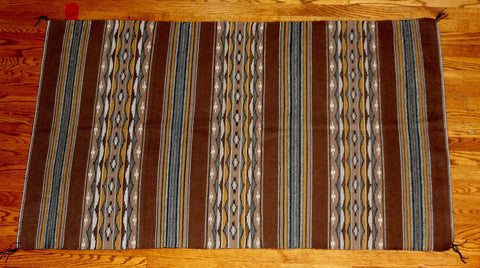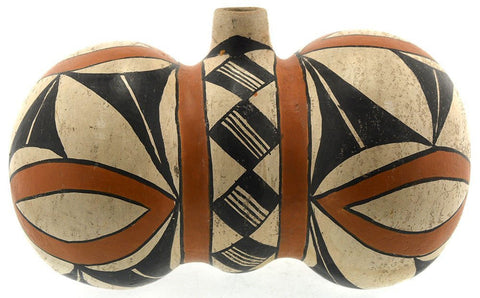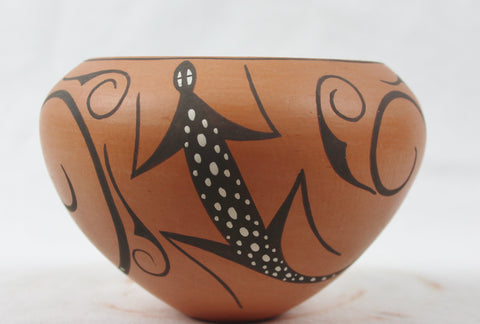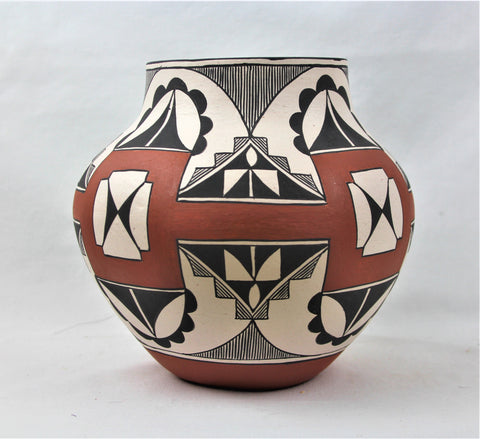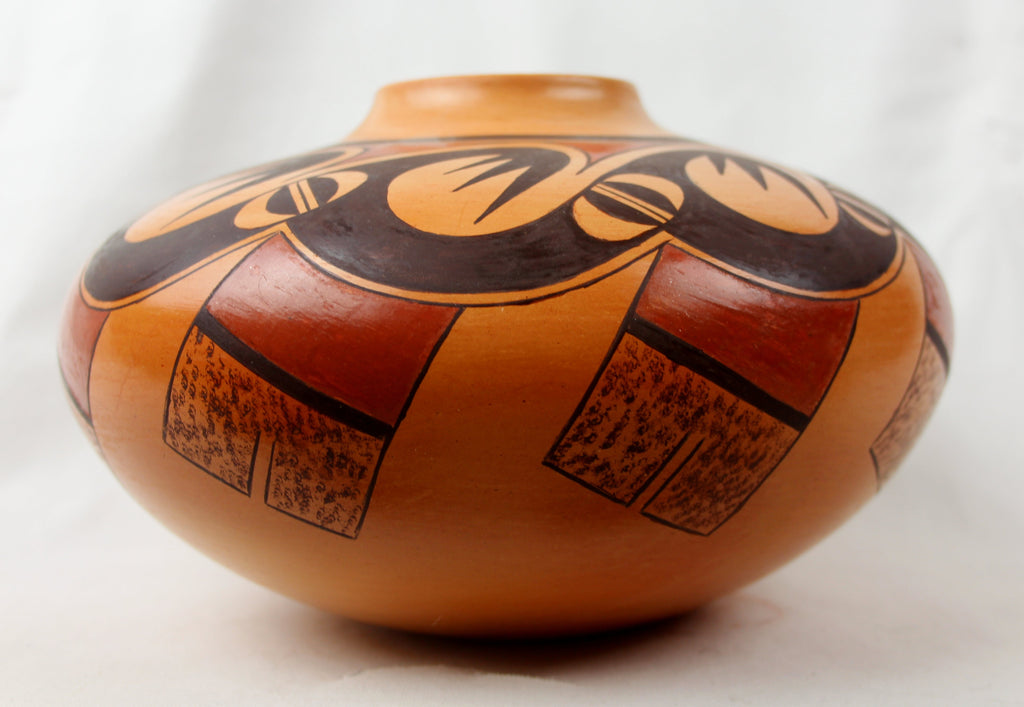
Native American Hopi Poly Chrome Bowl, by Tonita Nampayo, 2014, #1288-sold
$ 937.50
Native American Hopi Poly Chrome Bowl, by Tonita Nampayo, 2014, #1288
Description: #1288 Native American Hopi Poly Chrome Bowl, by Tonita Nampayo, 2014,
Dimensions: 8" x 5"
Condition: Excellent, like new
Tonita Hamilton Nampeyo, Hopi/Tewa, Corn Clan, active 1950-present: black and red on yellow jars. Granddaughter of Nampeyo; daughter of Fannie Polacca Nampeyo and Vinton Polacca; wife of Eugene Hamilton; mother of Loren Hamilton; sister of Elva Tewaguna Nampeyo, Leah Garcia Nampeyo, Harold Polacca Nampeyo, Sr., Tom Polacca, Elsworth Polacca and Iris Youvella Nampeyo. Tonita continues making pottery in the traditional manner, using Sikyatki revival patterns, as taught her by her mother and grandmother. Reference: Hopi-Tewa Pottery: 500 Artist Biographies by Gregory Schaaf. (Source: Adobe Gallery)
Considered the true matriarch of the remaining Nampeyo family, Tonita is the eldest daughter of Fannie Nampeyo, and grand-daughter to the legendary Nampeyo who was credited as being instrumental in the revitalization of Hopi polychrome pottery.
In the footsteps of her forebears, Tonita stays true to her traditional roots, preferring to do everything the "old way." Her clay is still dug from deposits near her home. She still hand-coils and hand polishes every piece she does.
Tonita is world-renown and appears in nearly every publication dealing with Hopi pottery. Her work has been exhibited in galleries and museums across the globe, and she has shown and placed at nearly every major venue throughout the Southwest.
Her work appears in Fourteen Families in Pueblo Pottery by Rick Dillingham, The Art of the Hopi by Jerry Jacka, and Hopi-Tewa Pottery: 500 Artists Biographies by Gregory Schaff as well as others. (Source: Ancientnations.com)
“Pueblo pottery is made using a coiled technique that came into northern Arizona and New Mexico from the south, some 1500 years ago. In the four-corners region of the US, nineteen pueblos and villages have historically produced pottery. Although each of these pueblos use similar traditional methods of coiling, shaping, finishing and firing, the pottery from each is distinctive.
Various clay's gathered from each pueblo’s local sources produce pottery colors that range from buff to earthy yellows, oranges, and reds, as well as black. Fired pots are sometimes left plain and other times decorated—most frequently with paint and occasionally with appliqué. Painted designs vary from pueblo to pueblo, yet share an ancient iconography based on abstract representations of clouds, rain, feathers, birds, plants, animals and other natural world features.
Tempering materials and paints, also from natural sources, contribute further to the distinctiveness of each pueblo’s pottery. Some paints are derived from plants, others from minerals. Before firing, potters in some pueblos apply a light colored slip to their pottery, which creates a bright background for painted designs or simply a lighter color plain ware vessel. Designs are painted on before firing, traditionally with a brush fashioned from yucca fiber.
Different combinations of paint color, clay color, and slips are characteristic of different pueblos. Among them are black on cream, black on buff, black on red, dark brown and dark red on white (as found in Zuni pottery), matte red on red, and polychrome—a number of natural colors on one vessel (most typically associated with Hopi). Pueblo potters also produce undecorated polished black ware, black on black ware, and carved red and carved black wares.
Making pueblo pottery is a time-consuming effort that includes gathering and preparing the clay, building and shaping the coiled pot, gathering plants to make the colored dyes, constructing yucca brushes, and, often, making a clay slip. While some Pueblo artists fire in kilns, most still fire in the traditional way in an outside fire pit, covering their vessels with large potsherds and dried sheep dung. Pottery is left to bake for many hours, producing a high-fired result.
Today, Pueblo potters continuue to honor this centuries-old tradition of hand-coiled pottery production, yet value the need for contemporary artistic expression as well. They continue to improve their style, methods and designs, often combining traditional and contemporary techniques to create striking new works of art.” (Source: Museum of Northern Arizona)
----------
View the other items in my shop: http://www.etsy.com/shop/CulturalPatina?ref=shopsection_shophome_leftnav
Description: #1288 Native American Hopi Poly Chrome Bowl, by Tonita Nampayo, 2014,
Dimensions: 8" x 5"
Condition: Excellent, like new
Tonita Hamilton Nampeyo, Hopi/Tewa, Corn Clan, active 1950-present: black and red on yellow jars. Granddaughter of Nampeyo; daughter of Fannie Polacca Nampeyo and Vinton Polacca; wife of Eugene Hamilton; mother of Loren Hamilton; sister of Elva Tewaguna Nampeyo, Leah Garcia Nampeyo, Harold Polacca Nampeyo, Sr., Tom Polacca, Elsworth Polacca and Iris Youvella Nampeyo. Tonita continues making pottery in the traditional manner, using Sikyatki revival patterns, as taught her by her mother and grandmother. Reference: Hopi-Tewa Pottery: 500 Artist Biographies by Gregory Schaaf. (Source: Adobe Gallery)
Considered the true matriarch of the remaining Nampeyo family, Tonita is the eldest daughter of Fannie Nampeyo, and grand-daughter to the legendary Nampeyo who was credited as being instrumental in the revitalization of Hopi polychrome pottery.
In the footsteps of her forebears, Tonita stays true to her traditional roots, preferring to do everything the "old way." Her clay is still dug from deposits near her home. She still hand-coils and hand polishes every piece she does.
Tonita is world-renown and appears in nearly every publication dealing with Hopi pottery. Her work has been exhibited in galleries and museums across the globe, and she has shown and placed at nearly every major venue throughout the Southwest.
Her work appears in Fourteen Families in Pueblo Pottery by Rick Dillingham, The Art of the Hopi by Jerry Jacka, and Hopi-Tewa Pottery: 500 Artists Biographies by Gregory Schaff as well as others. (Source: Ancientnations.com)
“Pueblo pottery is made using a coiled technique that came into northern Arizona and New Mexico from the south, some 1500 years ago. In the four-corners region of the US, nineteen pueblos and villages have historically produced pottery. Although each of these pueblos use similar traditional methods of coiling, shaping, finishing and firing, the pottery from each is distinctive.
Various clay's gathered from each pueblo’s local sources produce pottery colors that range from buff to earthy yellows, oranges, and reds, as well as black. Fired pots are sometimes left plain and other times decorated—most frequently with paint and occasionally with appliqué. Painted designs vary from pueblo to pueblo, yet share an ancient iconography based on abstract representations of clouds, rain, feathers, birds, plants, animals and other natural world features.
Tempering materials and paints, also from natural sources, contribute further to the distinctiveness of each pueblo’s pottery. Some paints are derived from plants, others from minerals. Before firing, potters in some pueblos apply a light colored slip to their pottery, which creates a bright background for painted designs or simply a lighter color plain ware vessel. Designs are painted on before firing, traditionally with a brush fashioned from yucca fiber.
Different combinations of paint color, clay color, and slips are characteristic of different pueblos. Among them are black on cream, black on buff, black on red, dark brown and dark red on white (as found in Zuni pottery), matte red on red, and polychrome—a number of natural colors on one vessel (most typically associated with Hopi). Pueblo potters also produce undecorated polished black ware, black on black ware, and carved red and carved black wares.
Making pueblo pottery is a time-consuming effort that includes gathering and preparing the clay, building and shaping the coiled pot, gathering plants to make the colored dyes, constructing yucca brushes, and, often, making a clay slip. While some Pueblo artists fire in kilns, most still fire in the traditional way in an outside fire pit, covering their vessels with large potsherds and dried sheep dung. Pottery is left to bake for many hours, producing a high-fired result.
Today, Pueblo potters continuue to honor this centuries-old tradition of hand-coiled pottery production, yet value the need for contemporary artistic expression as well. They continue to improve their style, methods and designs, often combining traditional and contemporary techniques to create striking new works of art.” (Source: Museum of Northern Arizona)
----------
View the other items in my shop: http://www.etsy.com/shop/CulturalPatina?ref=shopsection_shophome_leftnav
Related Products
Sold out
Sold out
Sold out






